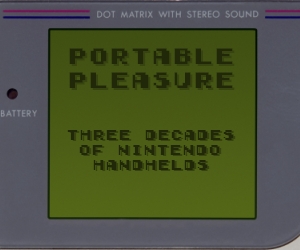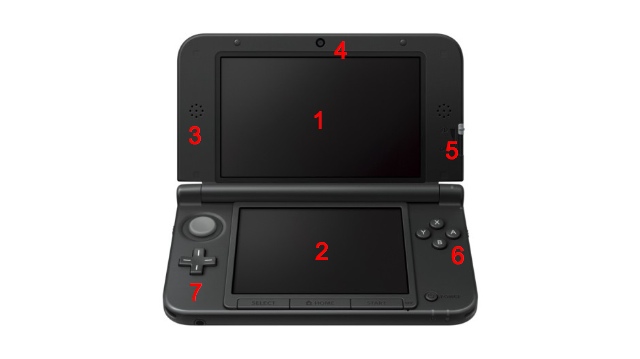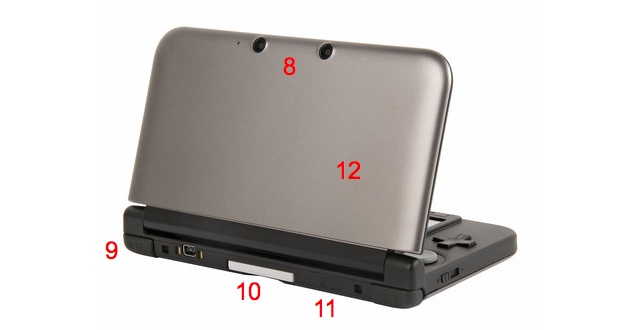Portable Pleasure: Three Decades of Nintendo Handhelds – Part Four: The Nintendo 3DS
 In this final part of Portable Pleasure, we explain how Nintendo’s latest portable console owes its entire design and functionality to its predecessors.
In this final part of Portable Pleasure, we explain how Nintendo’s latest portable console owes its entire design and functionality to its predecessors.
Modern technology is a result of decades of revolution and evolution, and both the Nintendo 3DS and its improved hardware revision, the 3DS XL are perfect examples of this.
To prove this theory, this final part of Portable Pleasure will take a pictorial look at the Nintendo 3DS XL, and I will show you how the last three decades of creating portable devices, has shaped the development of the Japanese giant’s most recent creation.
Front View
1. 3D Display
The 3DS’ unique display isn’t the first time a Nintendo portable has been able to output 3-Dimensional images (that award goes to the infamous Virtual Boy) and neither is it the second time. An Iwata Asks interview from early 2011 confirmed that Nintendo were working on an attachment for the Game Boy Advance SP that offered 3D output without glasses. Going further than that, the Gamecube actually contained circuitry that allowed for 3D imagery, should a special accessory be added. Unfortunately, neither of these accessories made it to retail.

2. Touchscreen
As we all know, the Touchscreen had its début with Nintendo’s popular DS line of portables. The 3DS adopts the same resistive technology as the DS models, which isn’t as advanced as the capacitive screens of the iPhone or PS Vita. However, it is a cheaper solution, which fits well with Nintendo’s policy of Lateral Thinking With Withered Technology.
3. Stereo Speakers
While Nintendo portables have had Stereo audio functionality since the original Game Boy, until the release of the Nintendo DS it was strictly headphone output only. Both the Nintendo DS and 3DS generations feature stereo speakers on the unit.
4. Front External Camera
Introduced by the Nintendo DSi hardware revision, both the 3DS and DSi models (and their XL revisions) feature a 0.3 Megapixel camera, which is quite poor compared to today’s standards.
5. Dual-Screen Configuration
The first Nintendo portable to feature two screens was the Oil Panic Game & Watch, and the idea was resurrected for the Nintendo DS (and later the 3DS).
6. Four Face Buttons
Once again, this is a DS addition that has made it’s way over to the 3DS, however it is weird that four face buttons hadn’t been introduced sooner, considering the Game Boy Advance shared a lot of similarities with the Super Nintendo console.
7. D-Pad
The D-Pad is a classic Nintendo-patented design for player movement,introduced with the NES console, but has been an integral part of Nintendo hardware ever since.

Rear View
8. External Cameras
Once again, introduced by the DSi system, the 3DS retains the poor 0.3 megapixel cameras of its predecessor, although the 3DS adds an extra external camera for taking 3D pictures (albeit grainy ones).
9. Shoulder Buttons
Inspired by the Super NES controller and now a stable of every major console afterwards, the Game Boy Advance introduced the use of shoulder buttons and has been adopted by every Nintendo portable since then.
10. Cartridges
Nintendo have always stood by their own proprietary media formats (the Nintendo Wii’s DVD drive being the only exception to the rule). Always preferring media that doesn’t require moving parts, the 3DS continues that trend with a cartridge that can currently hold up to 2GB of data.
11. Infrared I/O Port
Here’s an interesting one – The 3DS (and XL) feature a Infrared port on the back of the system. So far this has only been used to transfer I/O data between the 3DS and the Circle Pad Pro peripheral. However, the Game Boy Color also featured an infrared port, for linking systems together. However, this was only used in a few games (The Mission Impossible game also allowed you use the Game Boy Color as a television remote).
12. Clamshell Design
This is another throwback from the Game & Watch line of games, from their Multi series. The clamshell was brought back for the Game Boy Advance SP, and once again for the Nintendo DS/3DS range.
So there you have it, the 3DS is the ultimate evolution of the Nintendo school of design. That’s it for Portable Pleasure (You can read Parts One, Two & Three if you missed them). Thank you for reading!




